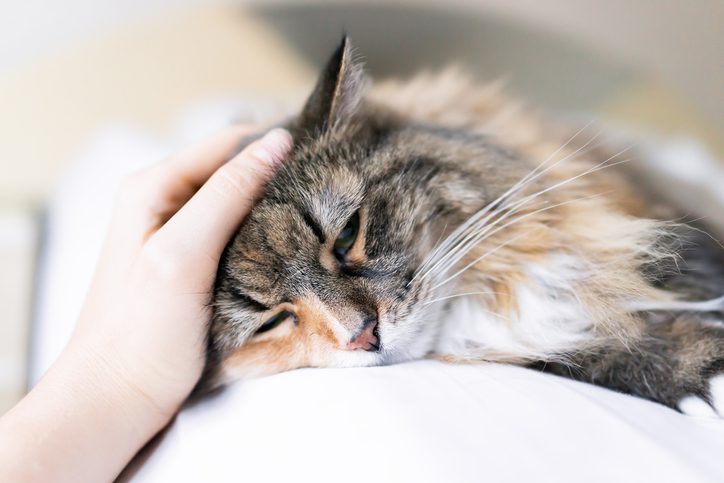Cats can be hard to care for sometimes. They are often very stoical, and this means that you might not be sure if they are feeling sick or just not feeling like being touched for some reason. Cats might also hide in a place where you cannot gain access to them when they are not feeling their best, which can make it hard to assess what their overall condition is.
When you think that your cat might be in pain, it can be helpful to know more about what cats do when they hurt. You might not have to guess at what your cat is experiencing if you see these common symptoms related to cat pain. Being sure that your cat needs help can be a relief so that you can schedule that vet visit that you think your pet might need.

1. Frequent Meowing
While some cat breeds are prone to being talkative, most cats do not meow all that often, especially if there is no one around to interact with. If your cat is meowing loudly or doing so consistently, they might be in pain. Yowling or really urgent cat meowing can also be a sign of being in pain.
If your cat is being much more talkative than usual, you should consider this a sign that something is making them feel off or painful. Be aware that if you have a Siamese cat or one of the more talkative cat breeds, this might not be an indication of anything abnormal since these cats tend to want to chatter all the time.
2. Panting
Cats that are in severe pain will often pant. They might do this with their mouth open or they can pant with their mouth closed as well. If your cat’s respiration seems to be increased significantly when compared to their normal breathing, this is often a sign that something is not right. Cats will not breathe visibly even when exerting in most cases, so a cat that you can see breathing rapidly is almost always in pain. This might also be a sign of poisoning, so you should take this symptom very seriously.
3. Hiding
Cats that are scared or worried or in pain will often hide out somewhere. This might be under the bed, in the closet, or your cat could even have a hiding place that you are not familiar with and cannot track down. Cats that are hiding are almost always not feeling very well, and you should consider this a sign that your cat might need to see the vet. If you have gotten a new pet or moved to a new location, you might wait a couple of days to see if your cat is just scared from the change of environment. However, if your cat continues to spend a lot of time hiding, you need to be sure to take them to the vet to be examined.
4. Trouble Moving Around
Cats are nimble and agile creatures, and they will almost never seem to have trouble getting around unless something is wrong. Older animals might be stiffer than they once were, but they should still be able to ambulate without a lot of trouble. If your cat seems to be struggling to get around, you should start paying attention to their behavior. Generalized physical pain can cause this kind of movement, but so can injuries like broken legs or the injuries that are related to cat fights can also cause this kind of behavior.
5. Behavior Changes
Cats that are in pain can sometimes seem to be angry, defensive, or unwilling to be touched. If your cat is normally really sweet and loves to be pet, you should consider a sudden change in this behavior as a sign that your cat might be in pain. Cats that are not usually friendly or easy to handle might be harder to diagnose based upon this symptom, but a cat that is normally sweet and friendly that will not let you touch them is of concern.
6. Limping
If your cat is limping or not using one of their legs, you should take them to the vet to have the leg looked at. Cats do not always land on their feet, and they can easily break their legs when falling. They might also be hit by cars or get into fights with other animals if they are allowed to be outside for part of each day. Limping is always a sign that something is wrong, and your cat should visit the vet for diagnosis of their injury if they are limping.
It Can be Hard to Tell When a Cat is in Pain
It can be hard to take care of your cat’s needs if they are the type of cat that goes into hiding when they are in pain or if they are not very friendly normally. Make sure that you pay attention to changes in appetite and other behavioral changes if your cat is not normally friendly or interactive with you and your family. Cats might hide that they are in pain for a long time before you notice the symptoms, but the more that you know about a cat in pain, the easier it can be to spot this symptom when it first shows up.
In most cases, these behaviors mean that your cat needs to see the vet for further diagnosis. Be sure that you do not wait too long to take your cat to the vet once you have seen signs that they might be in pain. Cats often hide these symptoms quite well for a long time, so your cat’s condition might be quite advanced by the time that you spot the symptoms. Caring for your cat’s pain can be easy if you know what signs to look for.
Do you have a cat in pain in Monroeville, PA? Call 412-373-8580 to talk with your veterinarian at Northern Pike Veterinary Hospital!

